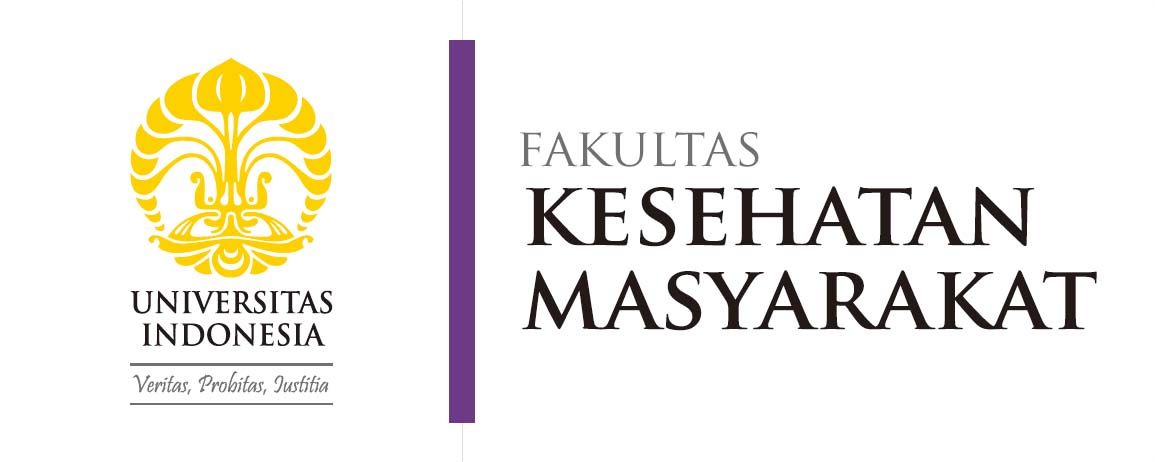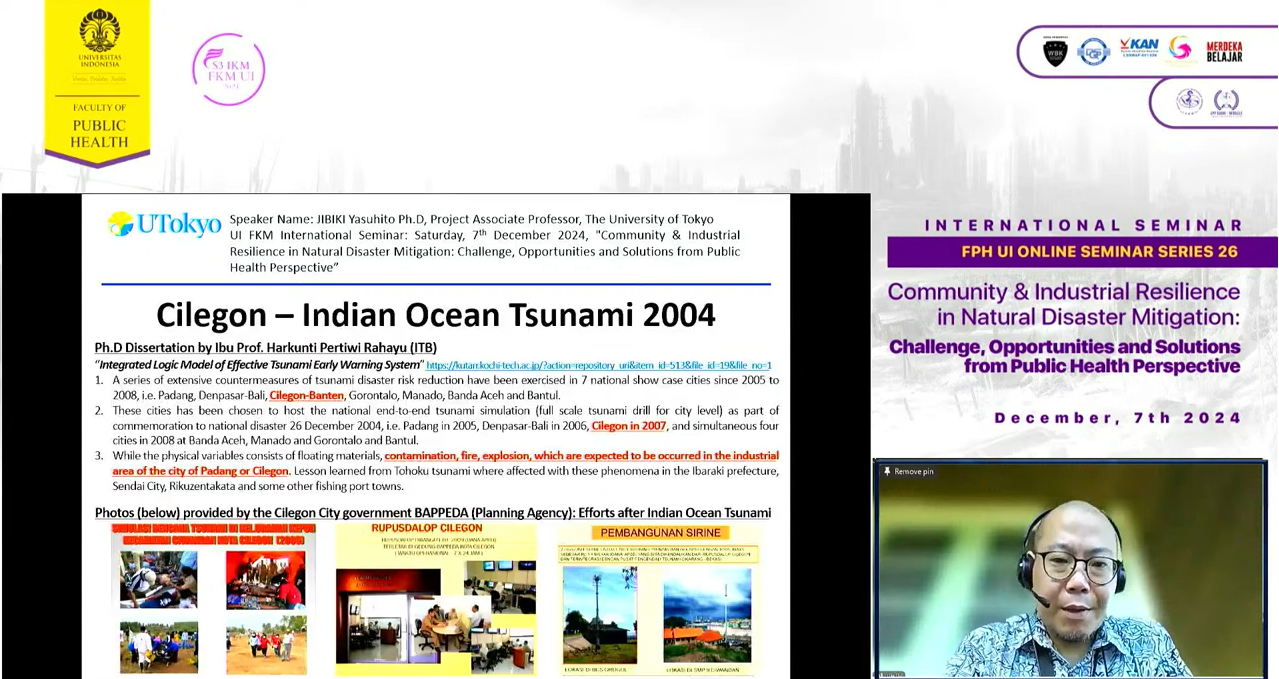Indonesia is known as one of the countries with the highest vulnerability to natural disasters in the world, such as earthquakes, tsunamis, volcanic eruptions, floods, and landslides. In addition to these natural disaster vulnerabilities, the increasing chemical industry activities in Southeast Asia, including Indonesia, further add to the risks of disasters that are a combination of technology and nature, commonly known as Natural and Technological Disasters (NATECH). The complexity of these challenges demands an integrated disaster management strategy that includes risk assessment, preparedness planning, and strengthening cross-sectoral capacities, as emphasized in the Sendai Framework for Disaster Risk Reduction 2015-2030. This approach highlights the importance of multi-party collaboration to build resilience in communities and industries against disasters.
In response to these challenges, the Faculty of Public Health (FPH) at the Universitas Indonesia (UI) held an Online Seminar FPH UI Series 26 on December 7, 2024, with the theme “Community and Industrial Resilience in Natural Disaster Mitigation: Challenges, Opportunities, and Solutions from a Public Health Perspective.” The event, conducted online via the Zoom Meeting platform, featured expert speakers in their respective fields and successfully attracted more than 400 participants, consisting of academics, practitioners, and the general public. This seminar became an important forum for sharing knowledge and science-based solutions to strengthen disaster preparedness.
The Rector of the University of Indonesia, Prof. Dr. Ir. Heri Hermansyah, S.T., M.Eng., IPU, opened the seminar by emphasizing the urgency of disaster mitigation amidst the increasing impact of global climate change. In his remarks, Prof. Heri expressed appreciation for the contributions of the speakers and the organizing committee. “Natural disasters and climate change affect various aspects of life, so cross-sector preparation involving academics, government, and society is crucial. This collaboration is key to building our resilience and readiness to face disaster risks,” he said.
The Vice Dean for Education, Research, and Student Affairs of FPH UI, Dr. Ir. Asih Setiarini, M.Sc., also gave a speech highlighting the relevance of the seminar’s theme in the context of increasing disaster risks due to climate change. Dr. Asih hoped that this seminar could serve as a platform for sharing insights, experiences, and innovations in strengthening disaster preparedness from a public health perspective. She also emphasized the importance of considering both mental and physical health aspects of individuals in disaster mitigation, as well as opening up opportunities for collaboration among stakeholders to create sustainable solutions.
Indonesia faces significant challenges in disaster mitigation, especially with the increasing impacts of the climate crisis, which is predicted to cause an additional 250,000 deaths between 2030 and 2050 due to malnutrition, malaria, diarrhea, and heat stress, according to the WHO. Meanwhile, Febi Dwirahmadi from Griffith University, Australia, discussed the health issues often arising during natural disasters, such as mortality, morbidity, and disruption of health infrastructure. “In natural disasters, there are many challenges, such as the handling of infectious diseases, sanitation disruptions, and mental health and nutrition issues in the community,” said Febi. Therefore, it is essential to have a public health preparedness system and healthcare service system that includes emergency operations coordination, victim management, medical material distribution, and public information management. This approach highlights that public health is a key component in building community resilience, where health promotion can be an effective strategy to improve preparedness and response to disasters.
Dr. Raditya Jati, S.Si., M.Si., Head of the Data, Information, and Communication Center for Disaster Management at the National Disaster Management Authority (BNPB), emphasized that climate change, land-use changes, and environmental damage are accelerating the increase in disaster risks. In addition, urbanization, poverty, environmental exploration, and the high population living in disaster-prone areas exacerbate these challenges. Dr. Raditya also pointed out weaknesses in disaster management governance, lack of public awareness, and limited disaster risk data, which hinder policy-making and its implementation. He stressed that disaster risk is dynamic and can increase or decrease depending on our ability to reduce vulnerability. “No region in Indonesia is completely free from disaster risks,” said Dr. Raditya. According to him, disaster risk patterns reflect the social construction of exposure and vulnerability, which vary in each country. In this context, a holistic approach that includes disaster-sensitive land-use planning and enhancing community capacity is crucial in efforts to build resilience to future disasters.
On the other hand, Dr. Sumarjaya, S.K.M., M.M., MFP., CFA., Head of the Health Crisis Center at the Indonesian Ministry of Health (Kemenkes RI), explained that health crisis management is carried out through a cluster system that involves both central and regional levels. This system aims to enhance coordination, collaboration capacity, and system integration in crisis management. The health cluster consists of regional clusters, sub-clusters, and teams tasked with fulfilling healthcare needs under one command. The crisis management phases include pre-crisis stages, such as risk assessment and contingency plan development; during-crisis stages, such as emergency declaration and activation of the health cluster; and post-crisis stages, which include evaluation and rebuilding healthcare services to be safer and more sustainable.
Meanwhile, Arief Bagus Arjuna, S.T., M.T., from PT Dover Chemical, Merak Plant, highlighted the industrial preparedness in facing disasters. “There is a need for emergency equipment such as sea level sensors, alarm systems, fire extinguishing equipment, and integrated evacuation procedures to deal with industrial disasters,” said Arief. The risk mitigation strategy for industrial disasters includes mutual assistance agreements between companies, emergency drills with companies, communities, and governments, as well as inter-company resource mapping. Arief also emphasized the importance of employee and public awareness, communication procedures between companies and governments, and the management of evacuation routes and gathering points to ensure effective disaster response.
Additionally, according to Prof. Dra. Fatma Lestari, M.Si., Ph.D., from the Disaster Risk Reduction Centre at the University of Indonesia, industries are also faced with the urgency of building resilience against disasters to protect human lives, assets, properties, and reputation. Prof. Fatma explained, “Disaster resilience also helps reduce losses and impacts experienced by companies and contributes to the overall resilience of the nation.” Indonesia, as a country in the Pacific Ring of Fire, is vulnerable to major earthquakes such as megathrust earthquakes that could trigger large tsunamis. Key challenges include risk communication, early warning systems, large populations, and ethnic diversity. “Vulnerable groups such as the elderly, children, and individuals with chronic diseases are often disproportionately affected,” added Prof. Fatma, while noting that limited healthcare infrastructure, overcrowded hospitals, and a shortage of healthcare workers worsen the situation. On the other hand, Prof. Fatma highlighted opportunities to improve resilience through local community involvement in disaster planning and response. “Technology can be utilized for early warning systems, health surveillance, and telemedicine services,” said Prof. Fatma. According to her, cross-sector collaboration is key to creating sustainable solutions in facing disaster challenges. Through these efforts, community and industrial resilience can be significantly improved, providing better protection against future disaster risks.
Prof. Ana Maria Cruz from Kyoto University, Japan, added that the conventional approach, which only focuses on facilities or infrastructure, needs to be expanded to a regional-based approach that includes surrounding industries and interconnected infrastructure. Prof. Cruz also emphasized the importance of readiness to face unforeseen situations and dynamic changes. This new paradigm demands comprehensive risk management that goes beyond individual facilities. Collaborative actions between local governments, companies, and communities are key in reducing NATECH risks—risks arising from the interaction between natural disasters and industrial accidents—especially in infrastructures like transportation pipelines that cross large areas and administrative boundaries. “NATECH risk management requires an integrated approach and cross-sector cooperation to ensure collective safety,” explained Prof. Ana Maria Cruz. This approach is believed to improve resilience to combined natural and technological disasters, which are becoming increasingly complex in the future. The importance of an inclusive disaster risk management approach to address various technological and environmental threats was also highlighted by Dr. Yasuhito Jibiki from Tohoku University, Japan.
The theme of this seminar reflects the importance of a holistic and collaborative approach in addressing disaster risks. Not only focusing on individual and community preparedness but also highlighting the resilience of the industrial sector in facing disaster threats. Through this forum, participants were expected to explore various challenges, opportunities, and concrete solutions based on scientific evidence that could be applied practically. The organization of the Online Seminar FPH UI Series 26 demonstrates the strategic role of FPH UI as an educational institution contributing to disaster mitigation efforts based on science and cross-sector collaboration. This seminar is expected to strengthen Indonesia’s preparedness in facing various disaster risks, both natural and technological, and promote sustainable national resilience development. (DFD)

